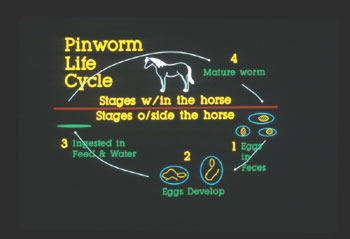Internal parasites are small organisms that live a portion of their life cycle in a host animal, the horse in this case. They live in internal organs, body cavities, and tissues while gaining their nutritive source by feeding on the host animal. The horse is affected by many different species of parasites. The nature and extent of damage varies with the parasite.
Parasite infestation causes loss of nutrients or blood from the host, resulting in serious medical problems. Horses heavily burdened with parasites will have a loss of condition due to a depletion of nutrients and blood, decreased growth, and reduced reproductive and athletic performance.
Numerous internal parasites infect horses, but there are only a few that commonly cause significant health problems. To establish an effective parasite control program, it is important to first understand the life cycle of parasites. Successful prevention and control programs are effective because they interrupt the life cycles of parasites. In some areas of the country, the primary class of internal parasites that cause health problems for horses are nematodes, such as large and small strongyles, ascarids, and tapeworms. Other internal parasites perhaps of lesser significance, such as pinworms and botfly larvae, are often considered when designing a parasite control program.
Pinworms
Pinworms are usually quite harmless. The most common sign of a horse with a heavy infestation of pinworms is itching of the anus caused by adhesive eggs deposited on the skin. Pinworms do not create as serious a health problem because their life cycle is not very harmful to the horse.
Craig Wood, University of Kentucky



